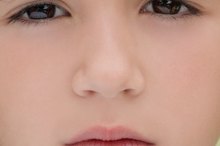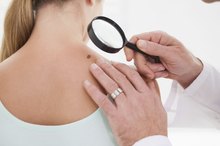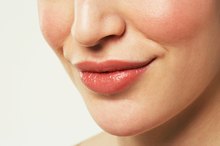Spots Under My Nose
Spots on the face, especially in visible places such as beneath the nose, can be frustrating and hard to conceal. They can be caused by a variety of skin conditions and environmental factors, some that are dangerous if left untreated. Therefore, it is important to understand what causes spots under the nose — and how they can be treated.
Symptoms
Spots under the nose can vary in color, texture and size. Some may be flat against the skin, while others may be large, raised bumps. They can vary in color from brownish-black to bright red. Symptoms can also include:
- itching
- swelling
- scaling
- inflammation
- tenderness
- pain
Facial spots may also contain pus that rises to the surface of the skin. These spots can also appear on other areas of the face and body.
- Spots under the nose can vary in color, texture and size.
- Some may be flat against the skin, while others may be large, raised bumps.
Causes
Red Bumps on the Forearm
Learn More
Age spots, which are caused by aging and excess exposure to ultraviolet light, can cause dark spots to develop on the face and body. Skin conditions such as eczema and acne can also result in red, inflamed spots beneath the nose. In addition, the KidsHealth website notes that skin spots can develop due to direct contact with an irritating substance, like a harsh soap or chemical. They can also occur when there is contact with an allergen, such as poison ivy or rubber.
- Age spots, which are caused by aging and excess exposure to ultraviolet light, can cause dark spots to develop on the face and body.
Treatment Options
Age spots beneath the nose can be treated with skin bleaching creams, laser treatments or cryotherapy. Pimples and eczema can benefit from over-the-counter medications with lactic acid or benzoyl peroxide in them. In addition, a doctor may suggest an emollient moisturizer, or calamine lotion, to keep skin moisturized and to soothe any itching and irritation. In severe cases, an antihistamine can also be used to treat eczema and allergy symptoms.
- Age spots beneath the nose can be treated with skin bleaching creams, laser treatments or cryotherapy.
- In addition, a doctor may suggest an emollient moisturizer, or calamine lotion, to keep skin moisturized and to soothe any itching and irritation.
Prevention
How to Remove Milia Under Eyes
Learn More
To prevent the development of liver spots under the nose, the MedlinePlus website suggests wearing a sunscreen of at least 30 SPF, even in the winter 1. Eczema and acne can be prevented by washing with a gentle cleanser two times a day to remove makeup and excess oil. Follow up with an oil-free moisturizer to keep skin hydrated. Keep a diary of when spots occur, and look for patterns of contact with particular substances and products.
- To prevent the development of liver spots under the nose, the MedlinePlus website suggests wearing a sunscreen of at least 30 SPF, even in the winter 1.
Considerations
Some spots under the nose can form quickly, while others can take many days to develop after contact with an allergen or irritating substance. The KidsHealth website recommends working with a doctor or dermatologist to pinpoint the food or other irritant triggering the spots. Try to refrain from scratching the spots beneath the nose. This can increase healing time and can even lead to an infection or permanent scar.
- Some spots under the nose can form quickly, while others can take many days to develop after contact with an allergen or irritating substance.
Related Articles
References
- MedlinePlus: Liver Spots
- MayoClinic: Acne
- KidsHealth: Rashes: The Itchy Truth
- American Academy of Dermatology. Variety of Options Available to Treat Pigmentation Problems. February 5, 2013. https://www.aad.org/media/news-releases/variety-of-options-available-to-treat-pigmentation-problems
- Tomecki J, Woodhouse G. Common Benign Growths. Cleveland Clinic Center for Continuing Education. http://www.clevelandclinicmeded.com/medicalpubs/diseasemanagement/dermatology/common-benign-growths/
- Scarcella G, Dethlefsen MW, Nielsen MCE. Treatment of solar lentigines using a combination of picosecond laser and biophotonic treatment. Clin Case Rep. 2018;6(9):1868-1870. doi:10.1002/ccr3.1749
- Scherer D, Kumar R. Genetics of pigmentation in skin cancer--a review. Mutat Res. 2010;705(2):141-53. doi:10.1016/j.mrrev.2010.06.002
- Bastiaens M, Hoefnagel J, Westendorp R, Vermeer BJ, Bouwes bavinck JN. Solar lentigines are strongly related to sun exposure in contrast to ephelides. Pigment Cell Res. 2004;17(3):225-9. doi:10.1111/j.1600-0749.2004.00131.x
- Davis EC, Callender VD. Postinflammatory hyperpigmentation: a review of the epidemiology, clinical features, and treatment options in skin of color. J Clin Aesthet Dermatol. 2010;3(7):20-31.
- George AO, Shittu OB, Enwerem E, Wachtel M, Kuti O. The incidence of lower mid-trunk hyperpigmentation (linea nigra) is affected by sex hormone levels. J Natl Med Assoc. 2005;97(5):685-8.
- Al-saif FM, Baqays AA, Alsaif HF, Alhumidi AA. Erythromelanosis follicularis faciei et colli with reticulated hyperpigmentation of the extremities. Clin Case Rep. 2017;5(10):1576-1579. doi:10.1002/ccr3.1095
- Dereure O. Drug-induced skin pigmentation. Epidemiology, diagnosis and treatment. Am J Clin Dermatol. 2001;2(4):253-62. doi:10.2165/00128071-200102040-00006
- Ammoury A, Michaud S, Paul C, et al. Photodistribution of blue-gray hyperpigmentation after amiodarone treatment: molecular characterization of amiodarone in the skin. Arch Dermatol. 2008;144(1):92-6. doi:10.1001/archdermatol.2007.25
- Jain A, Gupta N. Multifocal Bullous Fixed Drug Erruption Due To Phenytoin: A Lesson Learned! J Clin Diagn Res. 2015;9(12):OD04-5. doi:10.7860/JCDR/2015/15464.6908
- Mccarty M, Rosso JQ. Chronic administration of oral trimethoprim-sulfamethoxazole for acne vulgaris. J Clin Aesthet Dermatol. 2011;4(8):58-66.
- Massinde A, Ntubika S, Magoma M. Extensive hyperpigmentation during pregnancy: a case report. J Med Case Rep. 2011;5:464. doi:10.1186/1752-1947-5-464
- Sarkar SB, Sarkar S, Ghosh S, Bandyopadhyay S. Addison's disease. Contemp Clin Dent. 2012;3(4):484-6. doi:10.4103/0976-237X.107450
- Lause M, Kamboj A, Fernandez faith E. Dermatologic manifestations of endocrine disorders. Transl Pediatr. 2017;6(4):300-312. doi:10.21037/tp.2017.09.08
- Enguita FJ, Leitão AL. Hydroquinone: environmental pollution, toxicity, and microbial answers. Biomed Res Int. 2013;2013:542168. doi:10.1155/2013/542168
- Arora P, Sarkar R, Garg VK, Arya L. Lasers for treatment of melasma and post-inflammatory hyperpigmentation. J Cutan Aesthet Surg. 2012;5(2):93-103. doi:10.4103/0974-2077.99436
- Prohaska J, Badri T. Cryotherapy. StatPearls Publishing. 2019.
- Schalka S. New data on hyperpigmentation disorders. J Eur Acad Dermatol Venereol. 2017;31 Suppl 5:18-21. doi:10.1111/jdv.14411
- American Academy of Dermatology. Variety of Options Available to Treat Pigmentation Problems. February 5, 2013.
- Tomecki J, Woodhouse G. Common Benign Growths. Cleveland Clinic Center for Continuing Education.
Writer Bio
Rose Erickson has been a professional writer since 2010. She specializes in fitness, parenting, beauty, health, nutrition and saving money, and writes for several online publications including The Krazy Coupon Lady. She is also a novelist and a mother of three.









